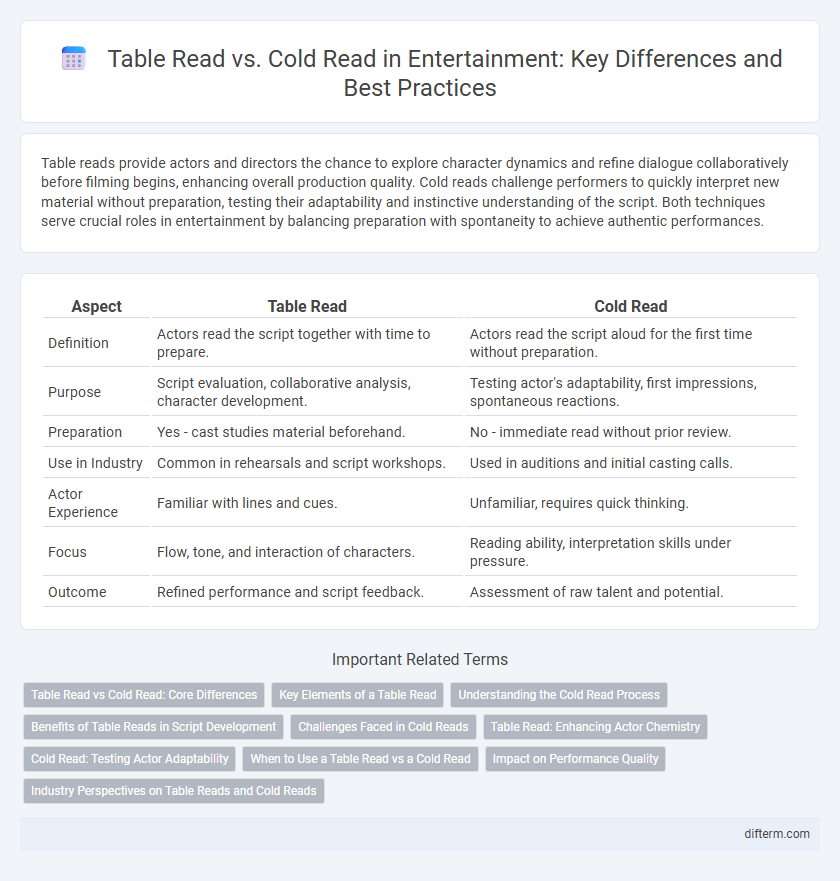Table reads provide actors and directors the chance to explore character dynamics and refine dialogue collaboratively before filming begins, enhancing overall production quality. Cold reads challenge performers to quickly interpret new material without preparation, testing their adaptability and instinctive understanding of the script. Both techniques serve crucial roles in entertainment by balancing preparation with spontaneity to achieve authentic performances.
Table of Comparison
| Aspect | Table Read | Cold Read |
|---|---|---|
| Definition | Actors read the script together with time to prepare. | Actors read the script aloud for the first time without preparation. |
| Purpose | Script evaluation, collaborative analysis, character development. | Testing actor's adaptability, first impressions, spontaneous reactions. |
| Preparation | Yes - cast studies material beforehand. | No - immediate read without prior review. |
| Use in Industry | Common in rehearsals and script workshops. | Used in auditions and initial casting calls. |
| Actor Experience | Familiar with lines and cues. | Unfamiliar, requires quick thinking. |
| Focus | Flow, tone, and interaction of characters. | Reading ability, interpretation skills under pressure. |
| Outcome | Refined performance and script feedback. | Assessment of raw talent and potential. |
Table Read vs Cold Read: Core Differences
Table reads involve actors rehearsing a script together, enhancing character chemistry and narrative flow through collaborative interpretation. Cold reads require actors to perform a script for the first time without prior rehearsal, testing spontaneity and raw interpretation skills. The core difference lies in preparation and interaction: table reads foster group synergy and script familiarity, while cold reads emphasize immediate comprehension and adaptability.
Key Elements of a Table Read
A table read involves actors sitting together to read the full script aloud, focusing on dialogue flow, character interaction, and pacing, allowing immediate feedback and script adjustments. Key elements include collaborative script analysis, vocal expression, and emotional delivery, which help identify narrative strengths and weaknesses early in production. Unlike cold reads, table reads foster a cohesive understanding of characters and story arcs, improving overall performance quality.
Understanding the Cold Read Process
The cold read process involves actors performing a script for the first time without prior rehearsal, emphasizing their ability to quickly interpret and convey the character's emotions and intentions. This technique is crucial during auditions and table reads, showcasing spontaneity and genuine reactions that can reveal an actor's raw talent. Mastering cold reads enhances adaptability and sharpens interpretive skills essential for dynamic performances in theater and film.
Benefits of Table Reads in Script Development
Table reads enhance script development by allowing actors and writers to collaboratively identify dialogue issues and character inconsistencies in real-time. The interactive environment fosters immediate feedback, leading to more natural, refined conversations and stronger narrative flow. This process helps uncover pacing problems and emotional beats that cold reads often miss, ultimately improving overall script quality before production.
Challenges Faced in Cold Reads
Cold reads pose significant challenges for actors, including limited time to understand characters and interpret scripts without prior preparation. The absence of rehearsal increases the difficulty in delivering natural emotions and timing, often resulting in less nuanced performances. Furthermore, actors must quickly adapt to other cast members' interpretations, requiring heightened focus and flexibility during table reads.
Table Read: Enhancing Actor Chemistry
Table reads foster stronger actor chemistry by allowing performers to hear their lines out loud together, enhancing timing and emotional connection. This collaborative environment helps actors understand character relationships and narrative flow more deeply than isolated cold reads. As a result, table reads contribute to more authentic and dynamic performances during production.
Cold Read: Testing Actor Adaptability
Cold reads assess an actor's adaptability by requiring them to perform a script with little to no preparation, showcasing their ability to quickly interpret character and dialogue. This method is widely used in auditions to evaluate an actor's spontaneity, emotional range, and quick decision-making under pressure. Casting directors rely on cold reads to identify talent who can deliver compelling performances in dynamic and unpredictable environments.
When to Use a Table Read vs a Cold Read
Table reads are ideal during later rehearsal stages for refining character interactions and pacing, offering actors a chance to hear the script aloud in a collaborative setting. Cold reads are best used in the early casting process or auditions to quickly assess an actor's adaptability and initial interpretation without prior preparation. Using table reads and cold reads strategically enhances script development and casting decisions in film, television, and theater production.
Impact on Performance Quality
Table reads enhance performance quality by allowing actors to internalize the script through collaborative discussion and feedback, leading to deeper character understanding and improved emotional delivery. Cold reads challenge actors to think on their feet, promoting spontaneity and raw emotional reactions, which can add authenticity but may lack refinement. Balancing table reads and cold reads often results in a more dynamic and polished performance.
Industry Perspectives on Table Reads and Cold Reads
Industry professionals value table reads for their ability to foster collaboration and refine scripts through actors' real-time feedback, enhancing character development and dialogue flow. Cold reads are favored in casting sessions to gauge an actor's instinctive interpretation and versatility without rehearsal, providing a raw glimpse of potential fit. Both methods play crucial roles in production stages, influencing casting decisions and script adjustments within the entertainment industry.
table read vs cold read Infographic

 difterm.com
difterm.com